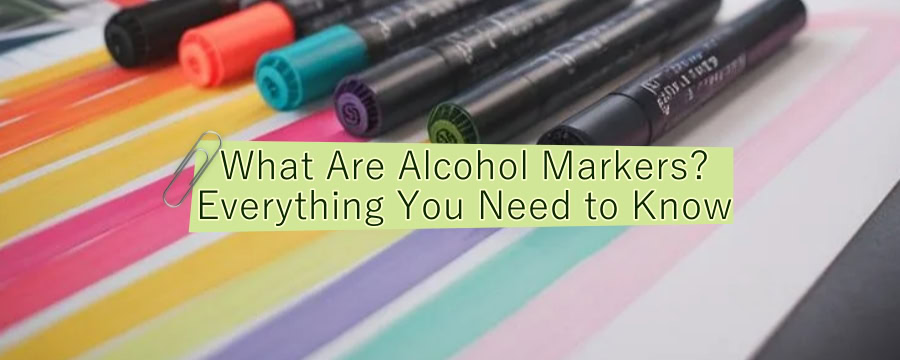Introduction
What are alcohol markers? In the stationery world, they’re a premium coloring tool favored by artists, designers, and creative professionals for their vibrant pigments, smooth blending, and long-lasting results.
Unlike standard water-based markers, alcohol markers use an alcohol-based ink formula that dries quickly and allows for seamless layering without damaging the paper.
In this article, we’ll explore their structure, compare them to other marker types, outline their advantages and limitations, and share tips on choosing and using them effectively. Let’s start!

What are alcohol markers?
Alcohol markers are professional-grade drawing tools. Their ink uses alcohol (ethanol or isopropyl alcohol) as its primary solvent, allowing the pigment to adhere quickly to the paper and evaporate quickly.
Compared to water-based markers, alcohol markers produce more vibrant, saturated colors and offer excellent color blending capabilities.
The following is a schematic diagram of the structure of an alcohol marker:

Alcohol-Based Ink: The core ingredient is ink dissolved in an alcohol solvent. This solvent allows the ink to dry rapidly and prevents feathering or bleeding.
Pigments: Finely ground colored pigments provide rich and vivid color. These pigments are suspended in the alcohol solution, giving the marker its intense and consistent color payoff.
Nibs: Usually, alcohol markers have dual tips—one broad chisel or brush tip for shading and blending, and one fine tip for detail work. The nibs are made of felt or synthetic fibers.
Marker Body and Ink Reservoir: The casing holds an internal reservoir saturated with the alcohol-based ink, ensuring a steady ink flow during use.
Alcohol Markers vs. Water-Based Markers
When choosing markers for your artistic or creative projects, understanding the differences between alcohol-based and water-based markers is essential.
Each type has unique properties that affect color vibrancy, drying time, blending ability, and suitability for various surfaces.
Let’s take a look at the core differences between alcohol markers and water-based markers.
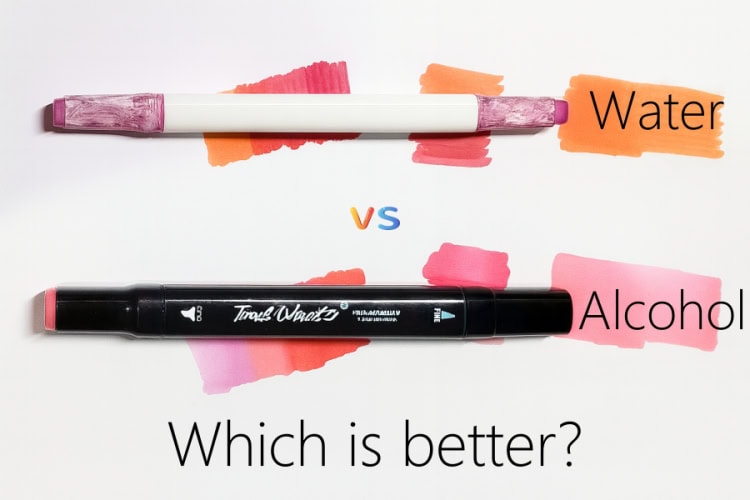
Water-Based vs. Alcohol-Based Markers: Core difference comparison
| Feature | Alcohol Markers | Water-Based Markers |
| Ink Base | Alcohol solvent (e.g., isopropyl alcohol) | Water solvent |
| Drying Time | Fast drying, usually within seconds | Slower drying, can stay wet for a while |
| Color Intensity | Vibrant, highly pigmented, bold colors | Softer, more translucent colors |
| Blendability | Excellent for smooth blending and gradients | Blendable but can be patchy or streaky |
| Bleed-Through | Can bleed through thin paper | Usually less bleed-through on standard paper |
| Surface Compatibility | Works well on various surfaces (paper, plastic, wood) | Primarily used on paper |
| Permanency | Permanent once dry, water-resistant | Can be reactivated or smudged with water |
| Odor | Noticeable alcohol smell | Usually odorless or mild scent |
| Use Cases | Professional art, design, illustration | Schoolwork, coloring books, general use |
| Cost | Generally more expensive | Usually more affordable |
Pros and Cons of Alcohol markers
Alcohol markers are popular in art and design due to their unique properties, but they also have some limitations. Here’s a detailed analysis of their pros and cons to help you fully understand whether they’re right for your needs.
Pros:
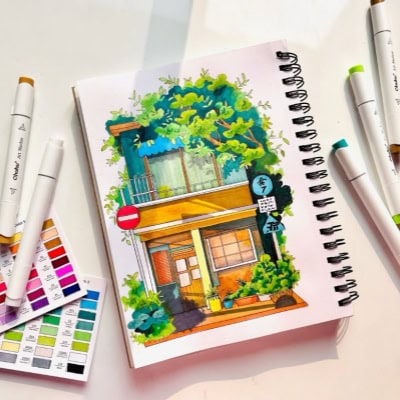
High Color Quality and Performance: Delivers rich, vibrant, and consistent color ideal for professional results.
Excellent for Layering and Special Effects: Allows smooth blending, shading, and color gradients without damaging the paper.
Versatile on Multiple Surfaces: Works well on paper, plastic, wood, fabric, metal, and more—ideal for mixed media applications.
Fast Drying and Smudge-Resistant: Ideal for quick-paced work and layering without long wait times.
Permanent and Fade-Resistant: Colors remain vibrant over time and won’t easily wash or rub off once dry.
Cons:

May Bleed Through Thin Paper: Works best on heavyweight, marker-friendly paper to avoid soak-through.
Higher Cost: Typically priced for serious hobbyists and professionals.
Strong Alcohol Odor: May be unpleasant in enclosed spaces—use in a well-ventilated area.
Not Easily Erasable or Washable: Once applied, the ink is permanent and difficult to correct.
Markers Can Dry Out If Uncapped: Always replace caps tightly to preserve ink life and performance.
Common uses of alcohol markers
Alcohol markers aren’t just for professional illustrators—they’re beloved across a wide range of creative fields for their vibrant color, smooth blending, and versatility on different surfaces.
From sketchbooks to product prototypes, these markers have found their way into countless industries and hobbies. Below are some of the most popular and practical ways people use them:
🎨 Illustration & Fine Art

Illustration:
Suitable for styles like realistic, anime, and fashion illustration.
Easily express light and shadow through layering and blending colors.
Comics & Character Design:
For outlining and coloring, alcohol markers with fine tips are perfect for outlining, while wide tips/brush tips are great for filling in.
Details like skin tones and hair gradients can be naturally rendered through color blending.
👗 Fashion and Product Design Sketches

Fashion Design:
Expressing fabric textures, wrinkles, and shadows, especially for designs requiring a high gloss, such as sportswear and formal wear.
Technique: Use a colorless blending pen (Blender) to simulate the transparency of silk or tulle.
Product Design Sketching:
Industrial designers often use alcohol markers to quickly render product materials, such as plastic, leather, and metal.
Advantage: The quick-drying nature makes it suitable for quick proposal revisions and avoids smudging the screen.
📚Stationery and Journaling
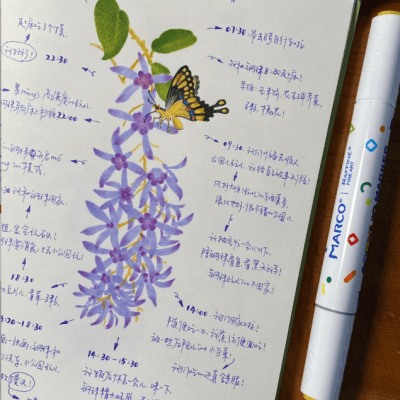
Bullet Journal Decoration:
Create titles, borders, and small icons. The colors last longer than with water-based markers.
Popular Uses: Pair with washi tape or stamps for collages.
Doodling & Lettering:
Soft-bristled brushes are ideal for brush lettering or gradient titles.
Note: Choose impermeable paper (e.g., 160g or higher).
Greeting Cards & Decorative Art:
Due to its bold colors and clean surface, it’s often used for custom greeting cards, invitations, and DIY projects.
🎯Other Creative Uses
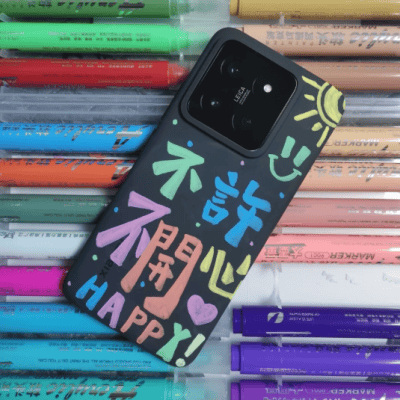
Model Painting:
Paint figurines, military models, etc.
Temporary Tattoos:
Alcohol-based ink can be left on the skin for a short time (certified safety products must be used).
DIY Crafts:
Decorate phone cases, wooden objects, stone paintings, etc.
Tips for Using Alcohol Markers
If you’re just getting started with alcohol markers—or even if you’ve been using them for a while—these tips can make a difference. They’re little tricks I’ve picked up along the way (some the hard way!), and they’ll help you get smoother blends, cleaner lines, and a much better overall experience.
1. Use the Right Paper
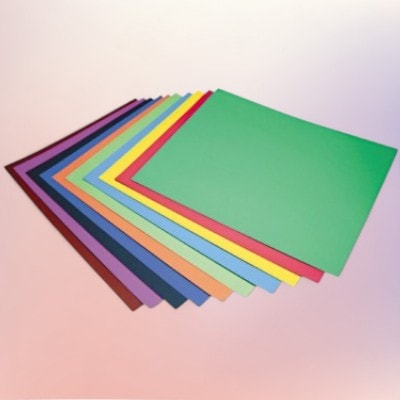
For the best results, choose thick, smooth, bleedproof paper such as marker pads or Bristol board. This helps prevent ink from feathering and keeps your colors vibrant. If you’re not sure which paper works best, check out 20 Different Types of Paper and Uses: The Ultimate Guide for more details.
2. Blend while it’s still wet

Alcohol ink is magic when it’s fresh. Want those dreamy gradients? Work quickly while the ink is still wet to get those soft, beautiful transitions. Start with lighter shades and gradually layer darker tones. This makes blending easier and avoids muddying your colors. Alcohol markers are transparent, so dark colors will overpower light ones if applied first.
3. Cap your markers right away
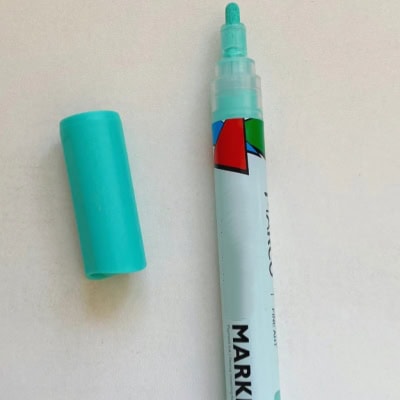
Alcohol ink dries quickly—that’s one of its best traits, but it also means your marker can dry out if left open for too long. Make it a habit: cap one marker before picking up the next. It’s a small gesture that goes a long way in preserving the life of your markers.
4. Store them horizontally

Horizontal storage is important, especially for dual-tip markers. It keeps the ink evenly distributed between both ends so neither tip dries out or gets oversaturated. A simple pencil case, zippered pouch, or marker organizer tray can keep things tidy and prolong your marker’s life.
5. Layer for Depth

Alcohol markers are great for layering—each layer adds richness without damaging the paper. Apply multiple light layers instead of one heavy layer for richer color. Let each layer dry slightly before adding the next. It’s a simple trick that gives your artwork depth and life. Don’t be afraid to experiment!
How to Choose the Right Alcohol Marker?
With so many brands, styles, and price points available, choosing the right alcohol marker can be a bit daunting. But don’t worry! With a little guidance, you can find the perfect match for your creative style, skill level, and budget. Here are some key things to keep in mind:
✒️ Tip Type Matters

One of the first things to consider is the type of tip the marker has. Most alcohol markers come with dual tips—typically a brush tip on one end and a chisel or fine tip on the other.
- Brush Tips are soft and flexible, making them perfect for blending, shading, and creating expressive strokes.
- Chisel Tips are great for covering large areas or creating bold lines.
- Fine Tips offer precision and are ideal for detailed line work and smaller illustrations.
If you do a lot of coloring or blending, brush tips will likely be your best friend. But if you’re more focused on design work or line art, a fine or chisel tip might suit you better.
🎨 Color Selection
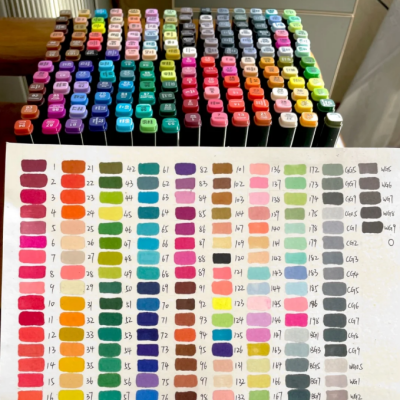
A good color range can make all the difference in how versatile your markers are. Some brands offer basic sets, while others have hundreds of colors, including specialty tones like skin tones, pastels, or neutrals.
Do you need rich, vibrant colors? Soft gradients? Earthy tones? Look for sets that offer a wide and balanced selection.
🔁 Refillable vs. Disposable
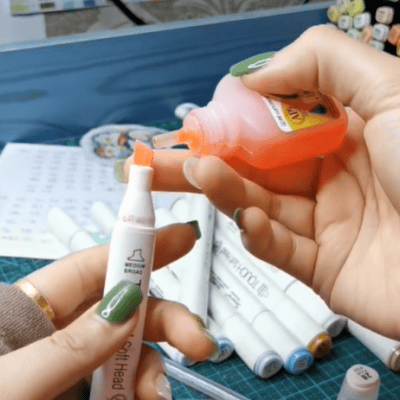
Some alcohol markers are refillable, meaning you can top them off with ink and replace the nibs when they wear out. These tend to be more expensive upfront, but save money in the long run—and they’re better for the environment too.
Disposable markers, on the other hand, are great for beginners or those who don’t use them as often, but they can dry out quickly and aren’t as durable.
💧 Ink Quality & Blendability
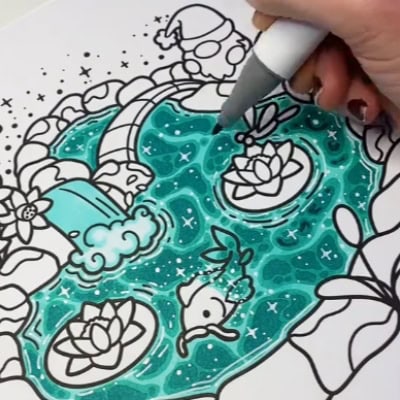
Not all alcohol markers are created equal when it comes to blending. Higher-quality markers tend to blend more smoothly, dry evenly, and maintain consistent color flow.
If you can, test out a few brands before committing. If you want to learn about high-quality alcohol marker brands, please refer to 7 Prominent Types of Marker Pens in 2025.
💰 Your Budget and Purpose

Are you a hobbyist, a student, or a professional illustrator? Your answer can guide your decision.
For beginners, student-grade markers are affordable and offer good performance for learning the basics.
For serious artists or designers, professional-grade markers offer superior color range, control, and reliability, and they’re worth the investment.
🌱Safe and Eco-Friendly

High-quality alcohol markers should carry international safety certifications such as AP (Approved Product) or CE to ensure they meet non-toxic standards. Choosing products labeled “Low VOC” can reduce irritating odors during use.
Environmentally friendly products also feature recyclable packaging and pen body designs. Ensure good ventilation when using them, allowing you to enjoy the fun of creation while also balancing health and environmental considerations.
FAQ
Are alcohol markers permanent?
Yes, alcohol markers are generally permanent once dry. They use an alcohol-based ink that dries quickly and adheres well to most surfaces, including paper, plastic, and metal.
The ink is water-resistant and doesn’t smudge easily, making it ideal for long-lasting artwork and designs.
While it may be removable from some smooth surfaces with rubbing alcohol, on paper and other porous materials, it’s effectively permanent.
Why are alcohol markers called alcohol markers?
Alcohol markers get their name from the type of solvent used in their ink. Instead of water (like in most standard markers), they use alcohol-based solvents—typically isopropyl alcohol or ethanol—to carry the pigment.
So, the name “alcohol markers” simply refers to the chemical base that powers their color delivery—and sets them apart from water-based or oil-based alternatives.
How to repair dried alcohol marker?
1. If refillable, use the brand’s refill ink to top it up.
2. If not, add a few drops of 91–99% isopropyl alcohol to the nib or inside the barrel to rehydrate the ink.
3. Replace the nib. If the tip is clogged or damaged, replacing it can restore ink flow.
How to make alcohol markers not bleed?
- Use high-quality marker paper: It’s designed to handle alcohol ink without soaking through.
- Work in thin layers: Over-saturating an area can cause the ink to spread beyond the lines.
- Apply slow, controlled strokes: Rushing can deposit too much ink at once.
- Place a backing sheet under your work: This protects your surface and absorbs excess ink.
How to store alcohol markers?
- Store horizontally: Especially for dual-tip markers, storing them flat keeps ink evenly distributed between both ends.
- Keep caps tightly closed: Alcohol ink evaporates quickly. Always cap markers firmly after use to prevent drying.
- Avoid direct sunlight and heat: High temperatures can dry out the ink or damage the plastic barrel. Store in a dry place.
- Use a case or organizer: A marker case keeps them secure, prevents damage, and makes it easy to find colors.
Are alcohol markers suitable for children?
They are best suited for teens and adults. Due to their permanent ink and fumes, they are not recommended for small children without supervision.
Conclusion
What are alcohol markers? The answer is clear. Alcohol markers are more than just a popular art supply; they’re a professional-grade tool that delivers consistent, high-quality results when used correctly.
By understanding their features, knowing how they differ from other markers, and selecting the right type for your needs.
My advice? Don’t be afraid to experiment. Try different techniques, mix and match colors, and see what works for your style.

